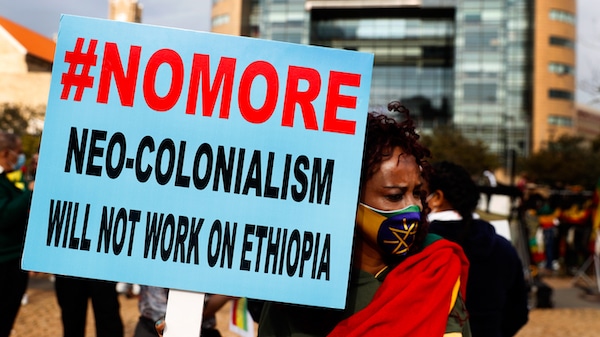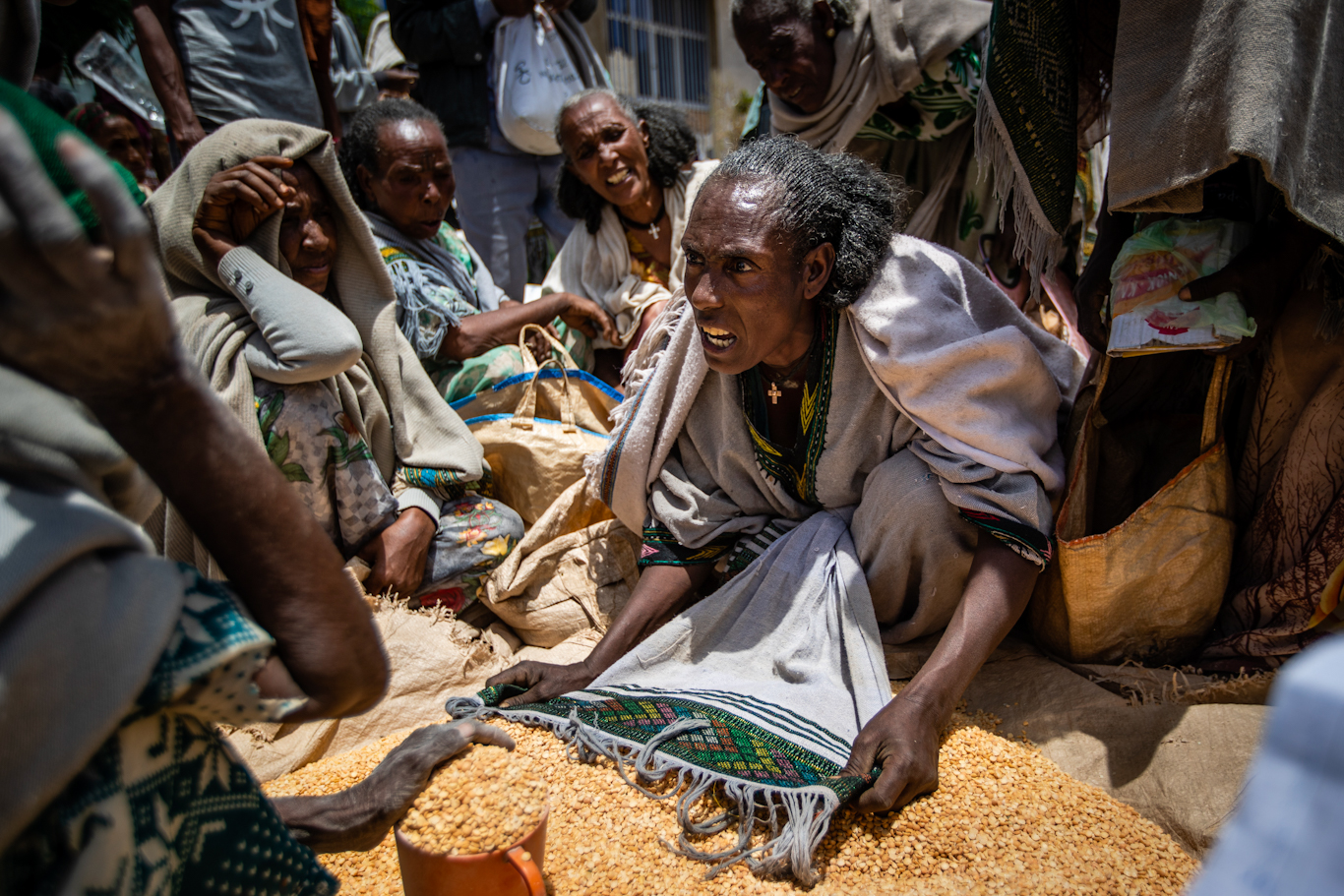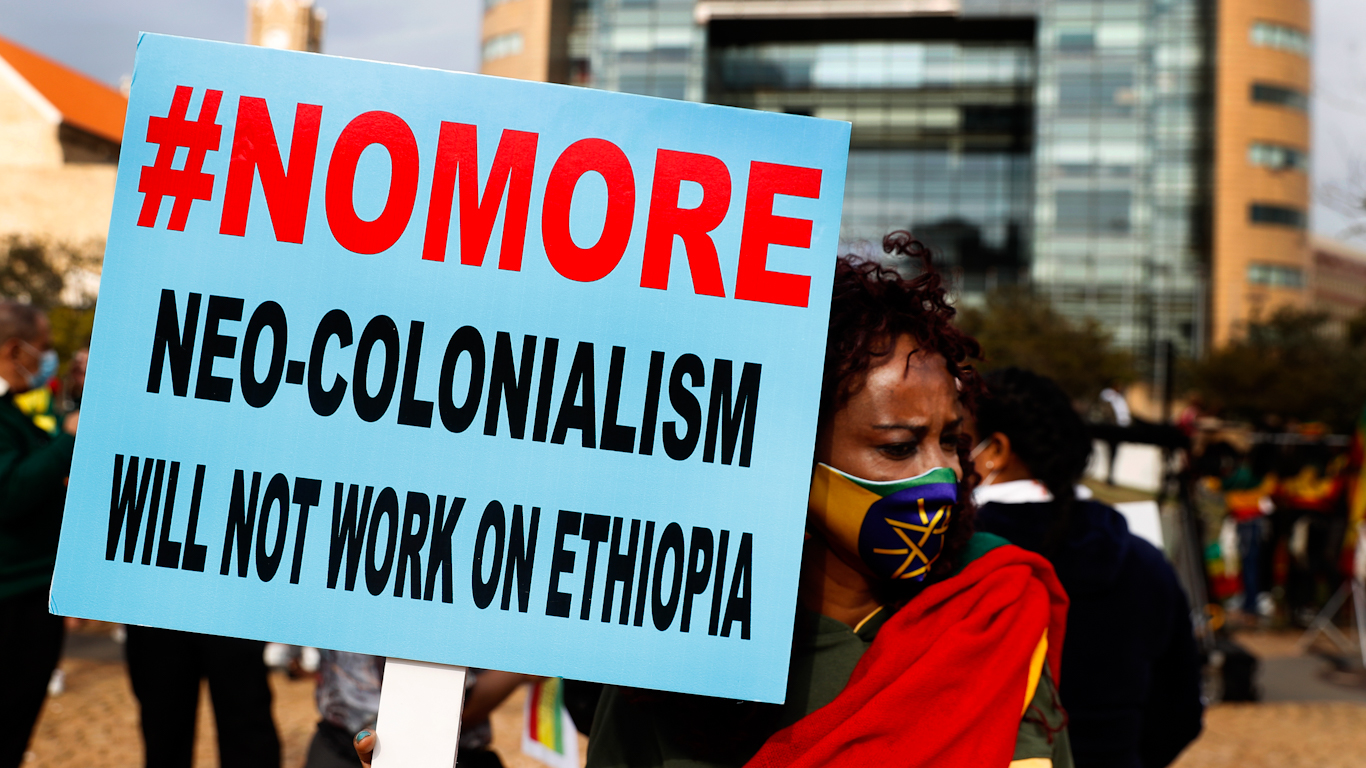We offer you this republished article by Alan MacLeod in Internationalist 360.

“Every option is on the table”: U.S. prepping for Libya-style intervention in Ethiopia
ADDIS ABABA, ETHIOPIA – Amid a bloody civil conflict and increasing great-power competition between the United States and China, there are a number of alarming signs that Ethiopia will become the next Libya – an African nation where the U.S. intervenes militarily under the pretext of stopping an impending genocide.
A considerable military buildup is now underway. Last week, the U.S. military announced it was sending over 1,000 National Guard members to nearby Djibouti. This is on top of the special operations forces already sent in November. Perhaps most notably, a government official told CNN that the aircraft carrier USS Essex – along with two other large amphibious vehicles – was steaming towards the Horn of Africa and standing by for further orders.
For weeks, the drums of war have been growing louder in our nation’s media. “Ethiopia’s civil war is a problem U.S. troops can help solve,” Admiral James Stavridis, former supreme allied commander of NATO. wrote in Bloomberg and The Washington Post. “Sending peacekeepers to the pivotal nation of East Africa wouldn’t be popular domestically, but may be the only way to stop the conflict,” he added. Meanwhile, former Assistant Secretary of State for African Affairs Jendayi Frazer argued that the West should establish a “no fly zone” across Ethiopia – a country of 115 million people and twice the size of France.
When it comes to Ethiopia, said head of USAID Samantha Power, one of the architects of the U.S. intervention in Libya, “every option is on the table” – using a phrase that has long been understood to be a threat of war. Secretary of State Antony Blinken also refused to rule out sending troops into Ethiopia when directly asked.
Given its bloody record, the talk of a “humanitarian” invasion has many Ethiopians worried. “The U.S. is looking for a pretext for military intervention in Ethiopia. The play books of interventions in Iraq, Syria, Yugoslavia, and Libya are being referred to,” Dr. Berhanu Taye, an Ethiopian physician and member of the Global Ethiopian Advocacy Nexus, told MintPress.
The military buildup comes on the back of economic actions already taken. In September, President Joe Biden labeled Ethiopia a national security threat as he imposed sanctions upon government officials. Last month, the U.S. also placed sanctions on Eritrea, whose troops are also heavily involved in the fight against the Tigray People’s Liberation Front (TPLF).
The White House is currently withholding over a quarter-billion dollars of aid from Ethiopia and has ended the country’s special trade status under U.S. law, which had allowed it to export goods freely to the United States. Critics say that this could have the effect of crashing the already shaky economy, threatening over a million jobs.
Earlier this week, a number of Western governments (including the U.S.) signed a statement condemning the Ethiopian government for its human rights violations while fighting the TPLF, which they did not censure. The State Department is reportedly considering labeling the actions in Ethiopia a “genocide,” a word that would have considerable implications, given NATO’s self-declared “right to protect” doctrine, whereby it claims it has the right to intervene anywhere in the world to stop ethnic cleansing.
A year of deadly fighting
Bordering Eritrea and Sudan, Tigray is Ethiopia’s northernmost region, home to 7 million people. Although ethnic Tigrayans constitute only around 6% of Ethiopia’s population, they play an outsized role in public life, as the TPLF controlled the country between 1991 and 2018, when popular protests forced them out of power.
Tigrayans were near ubiquitous in the upper ranks of the country’s military and intelligence services, and were greatly overrepresented among its economic elite. This, for Dr. Taye, amounted to no less than a system of informal “Apartheid” that was ignored by most of the West. MintPress also contacted a spokesperson for the TPLF, but did not receive a response.
Since coming to power in 2018, the new prime minister, Abiy Ahmed, has moved against the TPLF in a set of changes that supporters see as much needed reforms to reduce corruption and the TPLF’s grip over public life, but opponents see as overstepping his mandate and as the persecution of an ethnic minority.
The spark for war came in November 2020, when Ahmed attempted to remove military officers belonging to the TPLF from their command. The TPLF fought back, attacking Northern Command headquarters in Mekelle, the capital of the Tigray region. Later that month, TPLF forces also shelled Asmara, the capital of Eritrea. As the TPLF reportedly have drawn closer to the capital, Addis Ababa, a number of the country’s sports stars, including long-distance running hero Haile Gebrselassie, have volunteered for government military service.
 An Ethiopian woman argues with others over food aid in Tigray, northern Ethiopia, May 8, 2021. Ben Curtis | AP
An Ethiopian woman argues with others over food aid in Tigray, northern Ethiopia, May 8, 2021. Ben Curtis | AP
The fighting has continued since then, save for a unilateral government ceasefire in the summer in order that the country’s harvest would not be ruined. Nevertheless, the humanitarian costs have been extremely grave. More than 9 million people live in conflict regions, an estimated 400,000 of those suffering under famine-like conditions, according to the United Nations. Tens of thousands have died in the conflict, which has seen documented atrocities from all sides. The number of displaced people, already high, has now grown to an estimated 4 million.
The TPLF maintains that the Ethiopian government is blocking international aid convoys from reaching Tigray and that Prime Minister Abiy must step down. Yet Abiy won a landslide victory earlier this year, and was only inaugurated in October. While there were clear drawbacks with the process (voting did not take place in war-ravaged regions like Tigray, for instance), it is difficult to interpret his party winning over 90% of the seats contested as anything other than a national mandate.
Media’s demonizing chorus
Thus, the conflict is ultimately a struggle between two political forces for the control of Ethiopia’s economy. Yet this is not at all how corporate media have presented the issue, preferring instead to frame it as the Ethiopian and Eritrean governments exterminating an ethnic minority group. CNN, for example, wrote:
Eritrean troops aren’t just working hand in glove with the Ethiopian government, assisting in a merciless campaign against the Tigrayan people; in some pockets they’re fully in control and waging a reign of terror… [that] bears the hallmarks of genocide and has the potential to destabilize the wider Horn of Africa region.
The New York Times has followed a similar line in much of its reporting. Embedding themselves with the TPLF, they described their companions as “a scrappy force of local Tigrayan recruits” that had, against the odds, “scored a cascade of battlefield victories against the Ethiopian military, one of Africa’s strongest.”
Many Ethiopians have been critical of this coverage. Dr. Kassahun Melesse, an Ethiopian economist from the Oregon State University, noted:
Let alone the framing, the mainstream media got the most fundamental fact about the military conflict wrong: the date the military conflict between the Ethiopian National Defense Forces and the TPLF began. For instance, in virtually all of its reporting on conflict, The New York Times has stated that the federal government launched the war on Nov. 4, 2020. And because the media got this basic fact wrong, all the major theories and framing based on this premise are wrong.”
Taye was even more blunt. “Western mainstream media continue to fabricate lies and disseminate disinformation intended to demonize the Ethiopian government,” he said.
One example of bias pro-Abiy Ethiopians have pointed to is the Times’ apparent whitewashing of the TPLF’s alleged use of child soldiers. Possibly referring to this, the Times describes the TPLF as consisting largely of “highly motivated young recruits.” Even more incriminating, the article’s co-author shared a series of (since deleted) images on his Instagram to promote the story, one of which shows not only children but obviously pre-pubescent boys carrying rifles, complete with a caption seemingly describing them as “highly motivated young recruits.” The TPLF maintains that it does not use child soldiers.
via @besabestin, a New York Times photographer shared this image of the “highly motivated young recruits” he was talking about. pic.twitter.com/RQJfkmRXpn
— Alan MacLeod (@AlanRMacLeod) December 7, 2021
Unfortunately, many individuals challenging the established Western media narrative are now being excised from social media, including massive accounts – like @HornofAfricaHub, Simon Tesfamariam (@STesfa) and Abdirahiman Warsame’s @SomalianFacts – some of which had millions of followers. Ethiopian journalist Hermela Aregawi claimed that Twitter Senior Program Manager Martha Wolday, herself a Tigrayan, appeared to be abusing her position to ban anti-TPLF and pro-Abiy voices and suppress the anti-interventionist hashtag #NoMore.
Libya: a warning from history
At the height of the Arab Spring in 2011, demonstrations against Muammar al-Gaddafi broke out across Libya. Gaddafi had historically been a thorn in the side of the West, refusing to follow orders and attempting to unite both the Arab and African worlds against the established order. Seeing their chance, Western nations immediately began warning that the dictator was on the verge of massacring all those protesting his rule. Immediately, media were filled with lurid and false stories about Gaddafi giving his soldiers Viagra before making them rape protestors. We were, if accounts were to be believed, on the edge of genocide.
Obama era officials like Samantha Power and Susan Rice were among the loudest voices demanding a military response, invoking the controversial “Right to Protect” doctrine, which stated that NATO could intervene anywhere in the world to prevent human rights violations.
Media interest in Libyan human rights went through the roof, peaking in mid-March at the time of the intervention, before falling off a cliff and barely being discussed in the decade since, according to data from Google Trends. Despite the PR blitz, Americans remained dead against military intervention. Thus, it was intially sold to the public as merely imposing a “no-fly zone” on the country, to prevent Libyan planes from bombing forces we now know to have been U.S.-supported Jihadists.
Of course, NATO’s intervention quickly escalated far beyond a no-fly zone, turning the tide of the war and helping the beleagured Jihadists take Tripoli and depose Gaddafi. Since then, Libya has descended into chaos, replete with slave markets where one can buy humans for as little as $400. Today, Rice and Power are back in charge and there is already serious talk of imposing a no fly zone on the Horn of Africa. For many Ethiopians, things are starting to feel worryingly similar to 2011.
US legitimizes TPLF insurgence
The Tigray People’s Liberation Front came to power in 1991 after a long and bloody conflict against the military government of Mengistu Haile Mariam. The same conflict ultimately led to the independence of Eritrea from Ethiopia.
During their 27 years in office, the TPLF enmeshed itself into the state, with Tigrayans continuing to occupy senior positions across the country. Throughout this time, Ethiopia was a loyal ally of the United States, in contrast with the Marxist-Leninist Mengistu. Ethiopia helped the U.S. carry out its foreign policy objectives across the region. This support led to the United States turning a blind eye to many of its excesses. In 2015, for instance, President Barack Obama endorsed the country’s elections, where the TPLF coalition won 100% of the seats, as legitimate, while his State Department described Ethiopia as a “democracy.” This was in contrast to Human Rights Watch, which claimed it was “one of the most inhospitable places in the world for people speaking out against government policies, as well as for any human rights research and advocacy,” noting that the TPLF held thousands of political prisoners in the country’s prison system.
Melesse said that, by refusing to formally take a side between an elected government and a group that it has declared a terrorist organization, the U.S. has effectively legitimized the TPLF struggle. The reasons for this position, he argues, include “the return of several Obama-era officials in the U.S. State Department, USAID, and other U.S. government agencies who are sympathetic to the causes of the rebels in Tigray,” and “the misguided view within the U.S. foreign policy establishment that conflates support to the people of Tigray with support to the TPLF.”
 Samantha Power meets with ministers from donor countries to drum up financial support for Tigray. Photo | DVIDS
Samantha Power meets with ministers from donor countries to drum up financial support for Tigray. Photo | DVIDS
In November, the TPLF met with nine opposition political groups in Washington, where they signed an agreement to work together to depose Abiy and to form a rival government of their own. “As a response to the major crisis facing various nations of the country and to reverse the harmful effects of Abiy Ahmed’s autocratic rule, to our peoples and beyond, we have recognized the urgent need to collaborate, join our forces towards a safe transition in the country,” a spokesperson told gathered reporters. The symbolism of holding the event in Washington could hardly be missed.
The government fired back, claiming that their war was not only against the TPLF, “but also with colonialism of the powerful states of the West.”
US “Help” unwelcome
The background of this conflict also includes the wider geopolitical struggle between the United States and China. As part of its Belt and Road Initiative, a long-term plan to develop much of Afro-Eurasia and bring it economically closer to China, Beijing has been investing massively across Africa, with Ethiopia one of the continent’s top recipients of Chinese investment. Between 2000 and 2018, Ethiopia borrowed $13.7 billion from China, compared to $9.2 billion from the U.S. Most of that money has gone into huge infrastructure projects or to developing Ethiopian manufacturing.
Chinese money has helped build more than 50,000 kilometers of new roads since 2000, including an $86 million ring road for Addis Ababa. It has also funded the construction of a $475 million light railway system for the capital and the 750 kilometer Addis Ababa to Djibouti railroad, which will greatly boost trade and has reduced transport times from three days to ten hours. The Chinese-built port of Djibouti is rapidly becoming one of the world’s most advanced and busiest trading centers.
Walking the streets in Addis Ababa, individuals are as likely to see Chinese brands as American ones. Huawei and Tecno far outrank Apple in smartphone sales, with Infinix and Itel poised to overtake the California giant as well. China has signed dozens of memoranda of understanding with Ethiopia, helping it to become, by most measures, the country’s number one import and export partner. Currently, there are more than 10,000 Chinese firms doing business in the country.
The big loser in this is the U.S., which was long ago overtaken as Ethiopia’s primary economic partner. Americans have warned that this relationship is little more than debt-trap diplomacy, and that China is engaging in neocolonialism across Africa.
In recent years, the United States has become increasingly alarmed by China’s economic rise, and has attempted to stymie it. In addition to sanctions on Beijing, it has also tried to block the growth of Chinese tech companies like Huawei and TikTok, all the while building up its military in the South China Sea, under the guise of protecting Taiwan. Thus, there are fears that, as it is losing economic control over Ethiopia, the U.S. could be preparing to reassert control militarily.
For its part, the Chinese government has unequivocally backed Abiy. “China will steadfastly stand with the Ethiopian people, and keep to the consistent position of opposing external intervention in Ethiopia’s internal affairs with the disguise of human rights or democracy,” Zhao Zhiyuan, Chinese ambassador to Ethiopia, said last week.
However, it would be a mistake to label Abiy as some sort of communist Trojan Horse. As Melesse noted, this rupture with the U.S. was unexpected, as his government, “both in ideology and practice is more aligned with the West’s capitalist, liberal democratic order than was the TPLF-led regime it succeeded.” The new prime minister has passed a number of pro-market reforms and privatized government-owned businesses. He has also been willing to borrow money from both the International Monetary Fund and the World Bank, two institutions often seen as extensions of American power.
HAPPENING NOW: At least 500 members of Ethiopian & Eritrean diaspora are outside the State Dept demanding the US stop supporting TPLF terror & stop its economic aggression in the region.
“Joe Biden: Hands Off Ethiopia!”
“Hands off Eritrea!”
“USA! Stop supporting TPLF!”#NoMore pic.twitter.com/7hxS6WjgKi
— Wyatt Reed (@wyattreed13) December 10, 2021
The conflict in Tigray and other regions has devastated Ethiopian society. With the TPLF in a strong position and promising to march all the way to Addis Ababa to depose Abiy, it is unlikely that there will be any decisive military victory one way or another any time soon. This means that the humanitarian crisis will continue. Tens of thousands of refugees have fled to neighboring states, while continued violence threatens supplies of food and medicines.
While many clearly need help, judging by the large rallies held across the world, including in Washington, demanding “No More” U.S. intervention in Ethiopia and Eritrea, it seems clear that they are aware that the Biden administration’s idea of “help” might not be exactly what they had in mind.
 Feature photo | A protester from Ethiopia’s community in Lebanon holds a placard against the U.S. and other western country’s intervention in her country in Beirut, Lebanon, Dec. 5, 2021. Hussein Malla | AP
Feature photo | A protester from Ethiopia’s community in Lebanon holds a placard against the U.S. and other western country’s intervention in her country in Beirut, Lebanon, Dec. 5, 2021. Hussein Malla | AP
Alan MacLeod is Senior Staff Writer for MintPress News. After completing his PhD in 2017 he published two books: Bad News From Venezuela: Twenty Years of Fake News and Misreporting and Propaganda in the Information Age: Still Manufacturing Consent, as well as a number of academic articles. He has also contributed to FAIR.org, The Guardian, Salon, The Grayzone, Jacobin Magazine, and Common Dreams.
